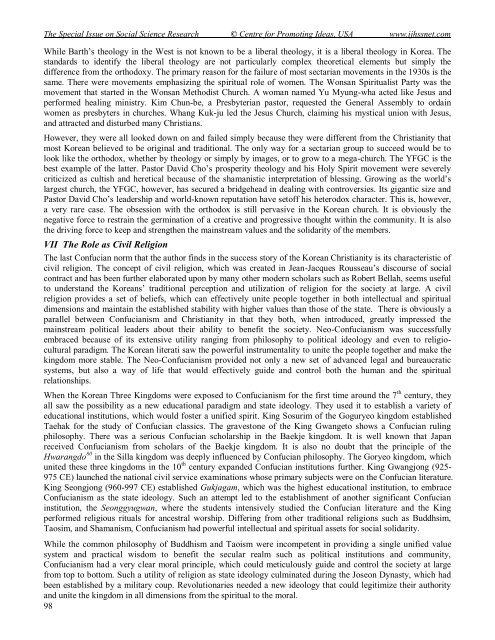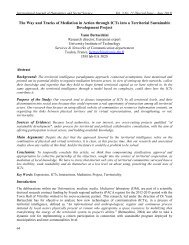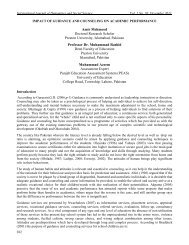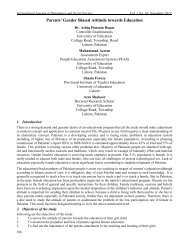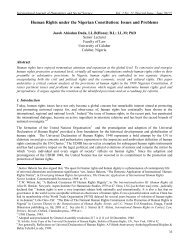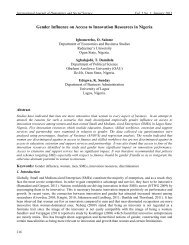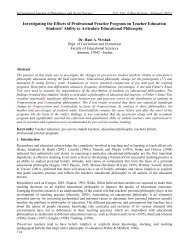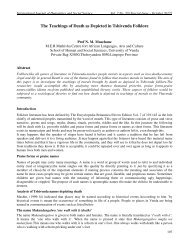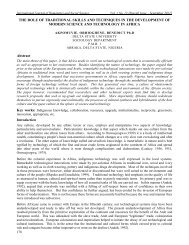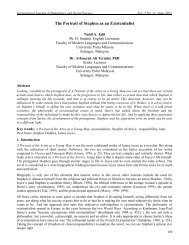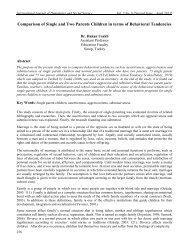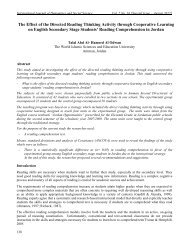Revisiting the Confucian Norms in Korean Church Growth
Revisiting the Confucian Norms in Korean Church Growth
Revisiting the Confucian Norms in Korean Church Growth
You also want an ePaper? Increase the reach of your titles
YUMPU automatically turns print PDFs into web optimized ePapers that Google loves.
The Special Issue on Social Science Research © Centre for Promot<strong>in</strong>g Ideas, USA www.ijhssnet.com<br />
While Barth‟s <strong>the</strong>ology <strong>in</strong> <strong>the</strong> West is not known to be a liberal <strong>the</strong>ology, it is a liberal <strong>the</strong>ology <strong>in</strong> Korea. The<br />
standards to identify <strong>the</strong> liberal <strong>the</strong>ology are not particularly complex <strong>the</strong>oretical elements but simply <strong>the</strong><br />
difference from <strong>the</strong> orthodoxy. The primary reason for <strong>the</strong> failure of most sectarian movements <strong>in</strong> <strong>the</strong> 1930s is <strong>the</strong><br />
same. There were movements emphasiz<strong>in</strong>g <strong>the</strong> spiritual role of women. The Wonsan Spiritualist Party was <strong>the</strong><br />
movement that started <strong>in</strong> <strong>the</strong> Wonsan Methodist <strong>Church</strong>. A woman named Yu Myung-wha acted like Jesus and<br />
performed heal<strong>in</strong>g m<strong>in</strong>istry. Kim Chun-be, a Presbyterian pastor, requested <strong>the</strong> General Assembly to orda<strong>in</strong><br />
women as presbyters <strong>in</strong> churches. Whang Kuk-ju led <strong>the</strong> Jesus <strong>Church</strong>, claim<strong>in</strong>g his mystical union with Jesus,<br />
and attracted and disturbed many Christians.<br />
However, <strong>the</strong>y were all looked down on and failed simply because <strong>the</strong>y were different from <strong>the</strong> Christianity that<br />
most <strong>Korean</strong> believed to be orig<strong>in</strong>al and traditional. The only way for a sectarian group to succeed would be to<br />
look like <strong>the</strong> orthodox, whe<strong>the</strong>r by <strong>the</strong>ology or simply by images, or to grow to a mega-church. The YFGC is <strong>the</strong><br />
best example of <strong>the</strong> latter. Pastor David Cho‟s prosperity <strong>the</strong>ology and his Holy Spirit movement were severely<br />
criticized as cultish and heretical because of <strong>the</strong> shamanistic <strong>in</strong>terpretation of bless<strong>in</strong>g. Grow<strong>in</strong>g as <strong>the</strong> world‟s<br />
largest church, <strong>the</strong> YFGC, however, has secured a bridgehead <strong>in</strong> deal<strong>in</strong>g with controversies. Its gigantic size and<br />
Pastor David Cho‟s leadership and world-known reputation have setoff his heterodox character. This is, however,<br />
a very rare case. The obsession with <strong>the</strong> orthodox is still pervasive <strong>in</strong> <strong>the</strong> <strong>Korean</strong> church. It is obviously <strong>the</strong><br />
negative force to restra<strong>in</strong> <strong>the</strong> germ<strong>in</strong>ation of a creative and progressive thought with<strong>in</strong> <strong>the</strong> community. It is also<br />
<strong>the</strong> driv<strong>in</strong>g force to keep and streng<strong>the</strong>n <strong>the</strong> ma<strong>in</strong>stream values and <strong>the</strong> solidarity of <strong>the</strong> members.<br />
VII The Role as Civil Religion<br />
The last <strong>Confucian</strong> norm that <strong>the</strong> author f<strong>in</strong>ds <strong>in</strong> <strong>the</strong> success story of <strong>the</strong> <strong>Korean</strong> Christianity is its characteristic of<br />
civil religion. The concept of civil religion, which was created <strong>in</strong> Jean-Jacques Rousseau‟s discourse of social<br />
contract and has been fur<strong>the</strong>r elaborated upon by many o<strong>the</strong>r modern scholars such as Robert Bellah, seems useful<br />
to understand <strong>the</strong> <strong>Korean</strong>s‟ traditional perception and utilization of religion for <strong>the</strong> society at large. A civil<br />
religion provides a set of beliefs, which can effectively unite people toge<strong>the</strong>r <strong>in</strong> both <strong>in</strong>tellectual and spiritual<br />
dimensions and ma<strong>in</strong>ta<strong>in</strong> <strong>the</strong> established stability with higher values than those of <strong>the</strong> state. There is obviously a<br />
parallel between <strong>Confucian</strong>ism and Christianity <strong>in</strong> that <strong>the</strong>y both, when <strong>in</strong>troduced, greatly impressed <strong>the</strong><br />
ma<strong>in</strong>stream political leaders about <strong>the</strong>ir ability to benefit <strong>the</strong> society. Neo-<strong>Confucian</strong>ism was successfully<br />
embraced because of its extensive utility rang<strong>in</strong>g from philosophy to political ideology and even to religiocultural<br />
paradigm. The <strong>Korean</strong> literati saw <strong>the</strong> powerful <strong>in</strong>strumentality to unite <strong>the</strong> people toge<strong>the</strong>r and make <strong>the</strong><br />
k<strong>in</strong>gdom more stable. The Neo-<strong>Confucian</strong>ism provided not only a new set of advanced legal and bureaucratic<br />
systems, but also a way of life that would effectively guide and control both <strong>the</strong> human and <strong>the</strong> spiritual<br />
relationships.<br />
When <strong>the</strong> <strong>Korean</strong> Three K<strong>in</strong>gdoms were exposed to <strong>Confucian</strong>ism for <strong>the</strong> first time around <strong>the</strong> 7 th century, <strong>the</strong>y<br />
all saw <strong>the</strong> possibility as a new educational paradigm and state ideology. They used it to establish a variety of<br />
educational <strong>in</strong>stitutions, which would foster a unified spirit. K<strong>in</strong>g Sosurim of <strong>the</strong> Goguryeo k<strong>in</strong>gdom established<br />
Taehak for <strong>the</strong> study of <strong>Confucian</strong> classics. The gravestone of <strong>the</strong> K<strong>in</strong>g Gwangeto shows a <strong>Confucian</strong> rul<strong>in</strong>g<br />
philosophy. There was a serious <strong>Confucian</strong> scholarship <strong>in</strong> <strong>the</strong> Baekje k<strong>in</strong>gdom. It is well known that Japan<br />
received <strong>Confucian</strong>ism from scholars of <strong>the</strong> Baekje k<strong>in</strong>gdom. It is also no doubt that <strong>the</strong> pr<strong>in</strong>ciple of <strong>the</strong><br />
Hwarangdo 80 <strong>in</strong> <strong>the</strong> Silla k<strong>in</strong>gdom was deeply <strong>in</strong>fluenced by <strong>Confucian</strong> philosophy. The Goryeo k<strong>in</strong>gdom, which<br />
united <strong>the</strong>se three k<strong>in</strong>gdoms <strong>in</strong> <strong>the</strong> 10 th century expanded <strong>Confucian</strong> <strong>in</strong>stitutions fur<strong>the</strong>r. K<strong>in</strong>g Gwangjong (925-<br />
975 CE) launched <strong>the</strong> national civil service exam<strong>in</strong>ations whose primary subjects were on <strong>the</strong> <strong>Confucian</strong> literature.<br />
K<strong>in</strong>g Seongjong (960-997 CE) established Gukjagam, which was <strong>the</strong> highest educational <strong>in</strong>stitution, to embrace<br />
<strong>Confucian</strong>ism as <strong>the</strong> state ideology. Such an attempt led to <strong>the</strong> establishment of ano<strong>the</strong>r significant <strong>Confucian</strong><br />
<strong>in</strong>stitution, <strong>the</strong> Seonggyugwan, where <strong>the</strong> students <strong>in</strong>tensively studied <strong>the</strong> <strong>Confucian</strong> literature and <strong>the</strong> K<strong>in</strong>g<br />
performed religious rituals for ancestral worship. Differ<strong>in</strong>g from o<strong>the</strong>r traditional religions such as Buddhsim,<br />
Taosim, and Shamanism, <strong>Confucian</strong>ism had powerful <strong>in</strong>tellectual and spiritual assets for social solidarity.<br />
While <strong>the</strong> common philosophy of Buddhism and Taoism were <strong>in</strong>competent <strong>in</strong> provid<strong>in</strong>g a s<strong>in</strong>gle unified value<br />
system and practical wisdom to benefit <strong>the</strong> secular realm such as political <strong>in</strong>stitutions and community,<br />
<strong>Confucian</strong>ism had a very clear moral pr<strong>in</strong>ciple, which could meticulously guide and control <strong>the</strong> society at large<br />
from top to bottom. Such a utility of religion as state ideology culm<strong>in</strong>ated dur<strong>in</strong>g <strong>the</strong> Joseon Dynasty, which had<br />
been established by a military coup. Revolutionaries needed a new ideology that could legitimize <strong>the</strong>ir authority<br />
and unite <strong>the</strong> k<strong>in</strong>gdom <strong>in</strong> all dimensions from <strong>the</strong> spiritual to <strong>the</strong> moral.<br />
98


